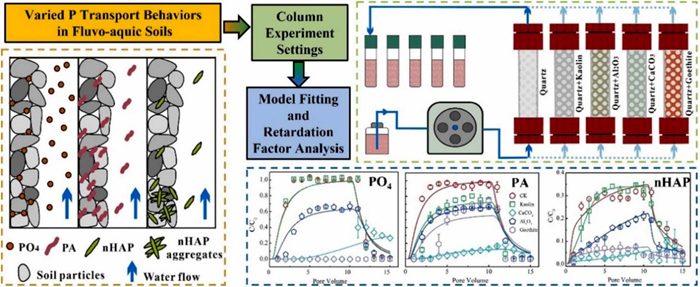The study reveals the retardation factors in controlling the transport of different phosphorus species in fluvo-aquic soil
Recently, the Agricultural Organic Pollution Bio-elimination Innovation Team at the Agro-Environmental Protection Institute, Ministry of Agriculture and Rural Affairs revealed the key factors to control the transport of different phosphorus (P) species in fluvo-aquic soil. These findings were published in the journal of Ecotoxicology and Environmental Safety .
Excessive application of fertilizers has caused a high load of P in the North China Plain. The fate of P and its effects on aquatic ecosystems depends on its chemical speciation in soils. However, few studies systematically investigated the transport and retardation of different P species in the fluvo-aquic soil.
In this study, the retardation of different P species from major soil components was clarified. The transport of P species in fluvo-aquic soil followed the order of inorganic P > organic P >
particulate P. Iron (hydr)oxides strongly inhibited inorganic P transport due to its high adsorption capacity, while calcium carbonates strongly inhibited organic P transport due to its strong association with organic P under alkaline conditions. Both calcium carbonates and iron (hydr)oxides can severely inhibit particulate P transport due to the favorable electrostatic conditions as well as the Ca2+bridging effect. These results indicated that calcium carbonates played a key role in regulating the retention of organic P and particulate P in the calcareous soil, and also suggested the important role of iron (hydr)oxides in controlling the transport of inorganic P, which could outcompete that of calcium carbonates. These results can provide insights into facilitating better assessments of the environmental behavior of P species and ultimately help to control the loss of P from soils.
The research was funded by the the National Key Research and Development Program of China, and the Innovation Engineering at the Chinese Academy of Agricultural Sciences (Correspondent: Jinling Yao)
Link: https://www.sciencedirect.com/science/article/pii/S0147651322012428
Contact: chenyali@caas.cn

-
 Apr 18, 2024Opening Ceremony of the Training Workshop on Wheat Head Scab Resistance Breeding and Pest Control in Africa Held in CAAS
Apr 18, 2024Opening Ceremony of the Training Workshop on Wheat Head Scab Resistance Breeding and Pest Control in Africa Held in CAAS -
 Apr 03, 2024IPPCAAS Co-organized the Training Workshop on Management and Application of Biopesticides in Nepal
Apr 03, 2024IPPCAAS Co-organized the Training Workshop on Management and Application of Biopesticides in Nepal -
 Mar 28, 2024Delegation from the School of Agriculture and Food Science of University College Dublin, Ireland Visit to IAS, CAAS
Mar 28, 2024Delegation from the School of Agriculture and Food Science of University College Dublin, Ireland Visit to IAS, CAAS -
 Mar 25, 2024Director of World Food Prize Foundation visited GSCAAS
Mar 25, 2024Director of World Food Prize Foundation visited GSCAAS -
 Mar 20, 2024Institute of Crop Sciences (ICS) and Syngenta Group Global Seeds Advance Collaborative Research in the Seed Industry
Mar 20, 2024Institute of Crop Sciences (ICS) and Syngenta Group Global Seeds Advance Collaborative Research in the Seed Industry
